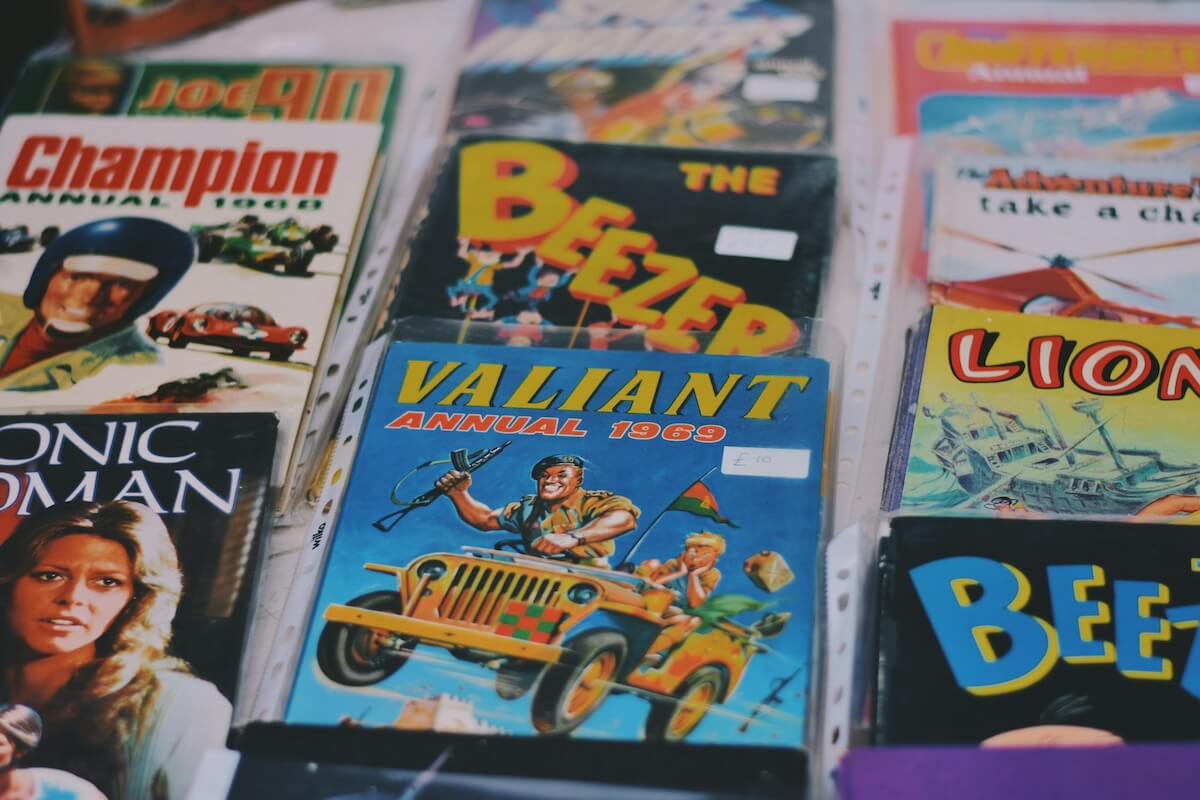Allen Bellman by by Dr. Michael J. Vassallo
Foreword…
The name Allen Bellman conjures up a smile of recognition among historians and aficionados of Timely Comics and Timely Comics history. From his beginnings as a teen-ager doing backgrounds for Syd Shores’ CAPTAIN AMERICA in 1942 up through THE PATRIOT, THE DESTROYER, THE HUMAN TORCH, JAP BUSTER JOHNSON, his self-created continuing crime feature LET’S PLAY DETECTIVE, the Atom-Age JET DIXON OF THE SPACE SQUADRON and scores of pre-code horror, crime, war and western tales for Atlas, Allen Bellman entertained us with a unique, distinctive and original comic book style. His career spanned the entire breadth of Timely/Atlas from the early golden-age to the dissolution of the Timely bullpen. He then joined the hundreds of freelancers whose work filled the myriad genres of titles that flourished after the decline and demise of the costumed heroes into the early 1950’s.
I tracked down Allen in Florida about 5 years ago thanks to a tip from Paul Curtis and began a close friendship that remains to this day. He is a storehouse of Timely reminiscences and looks back quite fondly on his career in the comic book industry. Allen had no existing copies of his comic book work and I was able to supply him with hundreds of pages, a sizable portion, of his Timely work. This material was drawn in the 1940’s and early 1950’s and had not been seen by him in over 50 years, nor had his family, his wonderful wife Roz or his children and grandchildren, “ever” seen it. This friendship and the validation of an artist’s career long thought forgotten, has proven to be as gratifying to this author as it has been to Allen.
I want to also mention that when this interview was originally conducted, Allen refers to his childhood friend Sam Burlockoff within the context that he had long passed away. During the piece’s long preparation, a very strange and happy situation presented itself in a coincidence that boggles my mind. Jim Amash called me up one day and asked me if I had ever heard of, or had any copies of Timely work done by an artist he was in the process of interviewing named Sam Burlockoff. I froze in astonishment and told Jim that I was at the same time interviewing his childhood friend, Timely artist Allen Bellman, and that Bellman thought him long deceased and mentions this in the interview.
Roy, Jim and I immediately realized we had a unique opportunity here. We’d put both interviews into the same issue and be able to get these two long lost friends back together in the process. With barely self-contained glee I called up Allen and told him
I had wonderful news for him. Asking him if he was sitting down, I related that accompany-ing his interview would be another interview by someone he knew long ago. I then told him that it was Sam Burlockoff, who was alive and well. The joy that emanated from the receiver cannot be reproduced here but needless to say it was something I will always treasure as having been a part of.

Allen Bellman & Sam Burlockoff 2003 reunion.
With that, I’ve decided to keep the original interview as is and the reader will note that when Allen mentions Sam early on it’s with the assumption that he was deceased but by the end of the interview, a part conducted “after” the happy revelation, he refers to Sam in the “present” tense. — Dr. Michael J. Vassallo
DocV@prodigy.net
MV: Let’s start at the beginning, Allen. Where and when were you born?
AB: I was born in Manhattan in New York City, on June 5th, 1924. Sometimes I get all choked up just thinking about that.
MV: About what?
AB: About how long ago it was and how quickly it seems to have passed.
MV: What part of Manhattan was it?
AB: The lower east side. A lot of my contemporaries were also born there.

Bellman, at about age three.
MV: It certainly was a cultural melting pot. Where were your parents from?
AB: Russia. They were Jewish immigrants running away from the pogroms.
MV: When did they come to America?
AB: Let’s see…the early part of the century. I have a picture of them that I’d never seen before until recently. My sister who passed away had it. My father is sitting in a chair with a stiff collar. You could just imagine that time.
MV: That would be about the same time my great grand parents arrived here also. Do you have any other siblings?
AB: I had one brother and 2 sisters. I’m looking at a picture of my brother right now that I recently printed out on my printer. He’s looking down at me as we speak. My parents were in the bakery business along with two or three of my uncles. They were the Bellman Brothers but after a while the partnership split and the brothers went their separate ways.
MV: So you grew up on the lower east side?
AB: No, not really. My parents migrated to Brooklyn along with my two sisters and brother. I was the youngest of the four and as the youngest that allowed me more privileges than the rest of my siblings, so they tell me.
MV: What section of Brooklyn?
AB: The old Brownsville section. Same place where Mike Tyson came from.
MV: That’s a tough neighborhood now.
AB: Then it wasn’t. It was a middle class Italian, Jewish neighborhood. Brownsville was the home of the Jewish Mafia widely known as “Murder Incorporated”. My father opened a bakery store.
MV: How old were you when you moved there?
AB: I guess I was 6 or 7 years old.
MV: You attended the local public school?
AB: Yes.
MV: How did your interest in art develop?
AB: In the bakery store. Everything was put in brown paper bags. At some point I started drawing on the bags. I suppose this was the start of printing on paper and plastic bags that we know today (laughs). I always wanted to tell a story in pictures. Airplanes intrigued me tremendously. As I got older, I started trying to draw my own comic strips. They were very crude.
MV: What do you remember about a young Stan Lee at Timely?
AB:I remember a funny incident. One day Stan walked into our room holding a cough medicine bottle and a spoon. I was a young smart ass kid and jokingly asked Stan if it was the “silver spoon” he was born with (laughs). He laughed but I always did regret saying that. Stan was wonderful to work for. He was good-natured but strict with his editing. He wanted perfection. If you drew a cup on a table in one panel, do not leave that cup out in the next panel.
MV: I’ll bet you read the comics in the newspapers.
AB: Oh sure! I remember when FLASH GORDON came out.
I’ll never forget the first time I saw it in the NEW YORK JOURNAL AMERICAN. Boy what a beautiful work. I was so impressed by it. Alex Raymond was one of my idols. His un-timely death was a great loss.
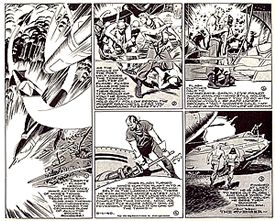
Alex Raymond Flash Gordon (Sept. 1, 1940)
MV: How did this influence you?
AB: Well, I was not in my teens yet and I was drawing comic strips on note book paper, in pencil. Later on I created characters like Mander the Mystic and Big Hank O’Malley that were run on the Aunt Jean page of the defunct BROOKLYN EAGLE.
The NEW YORK DAILY MIRROR published one of my cartoons, a box panel called Pete. It went something like this: One person says to the other, “I hear Hitler wants to be an athlete”. The other replied “Yeah, he wants to jump over the poles”. They paid me two dollars and that was the beginning of my career. This was at the time when dark clouds of war hovered over Europe and Hitler was marching on Poland.
MV: But what about at the very beginning? Lets get back to your teens.

New York Mirror
Sunday comic section (July 5, 1936)
AB: Before that I drew a comic strip called AIR PATROL for my school newspaper in Brooklyn.
MV: What school was that?
AB: It was in the Williamsburg/Greenpoint section of Brooklyn. I still remember that neighborhood well.
MV: I know that area. My roots are in Greenpoint also. The different ethnic groups change over the years but the houses are all the same from the turn of the century.
AB: I remember the Grand Street Theater on Grand Street.
MV: I think it’s still there! So you’re in your late teens and you’re drawing a comic strip for your high school newspaper. You obviously were good enough to think about art as a possible career, wouldn’t you say?
AB: Well I didn’t think about it as a “career”. I liked to do it, and in all honesty I didn’t think I was too good. I developed when I began working. Well someone “did” hire me so I must have been able to draw something! (laughs).
MV: In addition to the comic strips you read when you were young, I know you also admired Milton Caniff, who I’m going to come back to. Did you read comic books?
AB: Oh yes!
MV: Do you remember when the first Superman debuted?
AB: I was in junior high school. On our lunch hour there was a candy store. I went in and paid 10 cents for the first Superman in ACTION COMICS. I remember there was a guy running towards you and Superman was holding up a car.
MV: That’s the one!
AB: I remember it clearly. There was nothing previously on the newsstands like that. I wish I still had it.
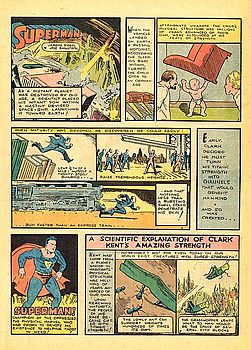
Action #1, pg. 1 (June 1938)
by Joe Shuster and Jerry Siegel
MV: It’s worth quite a bit of money. Even beat up it’s worth almost the price of a cheap car.
AB: Wow! I knew it was a collector’s item but I had no idea it was like that! I don’t know why there hasn’t been a movie made about Jerry Siegel and Joe Shuster. What happened to them is very sad.
MV: It “would” make for a terrific film story.
AB: I should suggest it to Michael Uslan. I’ve know him a long time and was a friend of his father. But it would show National, of the time, in a less than favorable light.
MV: It’s unfortunate but that’s how it was in the comic book business in those days. At the time of the Superman movie National caved in to pressure and finally relented to giving Siegal and Shuster a stipend for the rest of their life. They were somewhat forced by a strong groundswell in the comic book creative community. It started at $20,000 a year and was continually raised over the years. They didn’t have to do it but they may have wanted to avoid bad publicity on the eve of the movie’s debut. There was a large uproar and artists like Neal Adams championed their plight. It was the right thing to do or better yet, the “least” that they could do since those gentlemen started the entire industry and didn’t deserve to be living with sovery little means.
AB: I remember Joe Shuster working as a messenger for a company that made photo offsets. He had delivered these pieces of art to National. Can you imagine that? The man who made the company reduced to a messenger boy? What an injustice.
MV: There have been similar type stories like that about Shuster. Another is that someone who saw him up there, perhaps an editor, I don’t remember, told him to never show his face around there again. How many of those stories were true, I don’t know. There certainly was a lot of animosity remaining from their lawsuit with National over Superman.
AB: The trial could be a great part of such a movie about their life. Bob Kane seemed to do ok for years, though.
MV: Yes but that’s a story unto itself.
AB: I heard that he cut a deal with National or some such.
MV: To put it mildly, yes. Unfortunately in the process it negated the contributions of Bill Finger to history. Let’s get back to you. What prompted you to seek a job as an artist? Did you put together a portfolio of samples?
AB: Yes. They wouldn’t have ever hired me without seeing some samples.
MV: Where did the impetus come from?

High School of Industrial Arts
AB: I attended the High School of Industrial Arts and on and off, Pratt Institute. At age 17 or 18 I saw an ad in the newspaper. It was Columbus Day. I showed it to my father, may he rest in peace. He’s the one who encouraged me. He told me to go down there. I told him it was Columbus Day and that they’d probably be closed. He said “You gotta try”. Maybe I was a little lazy or I didn’t think I’d get the job, I don’t know, but I went. It was Timely Comics and they were in the McGraw Hill Building. I went up and told them I was there to apply for the job.
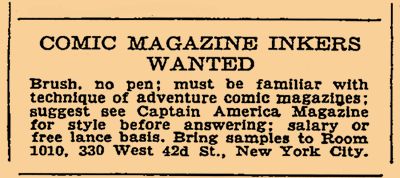
This was the September 6, 1942 ad (Labor Day) that ran in the
New York Times the month before the one Bellman saw.
So far, the ad for October 12 has not been located.
MV: What newspaper was the ad in?
AB: I think it was the New York Times.
MV: Was there a secretary there?
AB: Yes, a receptionist. She disappeared in the back for a minute and must have told whoever was in charge, someone was there for the job opening.
MV: What year was this?
AB: It was the early 1940’s.
MV: Well how old were you. Let’s pin this down exactly.
AB: I was 18.
MV: So that makes it October of 1942?
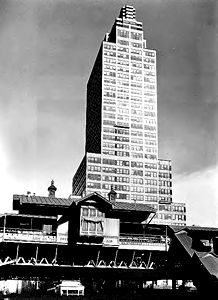
In 1942, the Timely offices were
located in the McGraw Hill Building
at 330 West 42nd Street.
AB: That would be about right.
MV: What exactly did the newspaper ad say?
AB: “Background artist wanted”. It was for CAPTAIN AMERICA..
MV: It stated that in the ad?
AB: I’m trying to remember, I’m not sure but I think it did.
MV: Ok. You see this ad for a background artist, you’re 18 years old, you go in and the receptionist tells whoever is in charge that you’re there for the job. Who comes out? Does Stan Lee come out?
AB: No. Don Rico comes out. He takes my work samples in. I waited a bit and he comes back out and tells me I’m hired.
MV: Boy, that was pretty quick, wasn’t it?
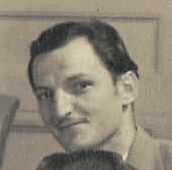
Don Rico, circa 1942
AB: Yes it was. He didn’t take long at all. It amazed me too. I think they started me off with $25 a week when at that time a married man with a family was making $35 to $45 a week. I thought I’d find it much tougher as I was only 18 years old. There was one other brush with the comic book business before I started at Timely. It has to do with Vin Sullivan. There was a story in the defunct BROOKLYN EAGLE newspaper that mentioned that a Vincent Sullivan was getting married and that he was organizing or working for a comic book publishing house. I contacted him and met him somewhere but nothing ever came of it.
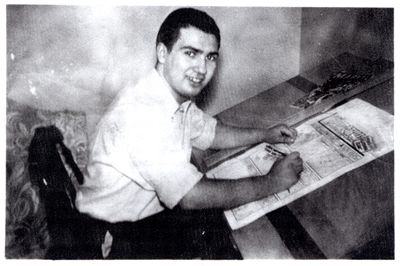
Bellman, circa 1945, at age 21. He is seen drawing his feature,
“Let’s Play Detective”.
MV: Vin Sullivan was one of the first editors at National and was the editor of ACTION COMICS #1. I believe that he also was the person to encourage Bob Kane to create a hero character, resulting in Batman. He later went on to start Magazine Enterprises.
AB: I wish something would have come of our meeting.
MV: Did you ever have any formal art training?
AB: My training was mostly experience. I learned so much on the job. My best friend Sam Burlockoff and I went to Pratt Institute at night on and off. It was in a bad neighborhood in Brooklyn and I didn’t like going at night.
MV: What neighborhood was that?
AB: It was downtown Brooklyn, DeKalb Avenue. I forget the exact section. I also took the Landon cartoon mail-order course. That’s about it. The rest was on-the-job.
MV: Now in October of 1942 CAPTAIN AMERICA would be up to about issue #22. Joe Simon and Jack Kirby had done the first 10 issues themselves and left Timely for National around the end of 1941.
AB: From what I remember, they had left about 9 months before I got there. There was always talk among the office staff about how great Simon and Kirby were. Syd Shores was doing it now. Vince Alascia may have been inking.
MV: In late 1942?
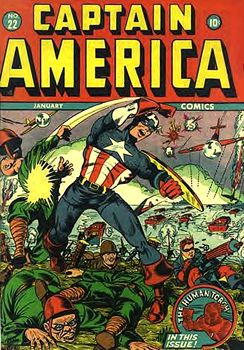
Captain America #22 (Jan. 1943)
[Syd Shores cover]
AB: Yes. Alascia was inking.
MV: Was Vince Alascia there that early on? I always placed Alascia inking Shores later on in the 1940’s. Did you start work right away?
AB: I think I went back home and started the following Monday.
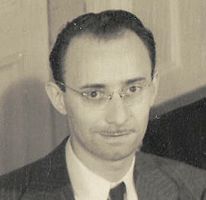
Vince Alascia, circa 1942
MV: Making this official, I guess you can say with certainty that the very first thing you did at Timely in October of 1942 was backgrounds for Syd Shores on CAPTAIN AMERICA?
AB: Yes.
MV: I’d love to find the exact story for you.
AB: Well it wasn’t much. It was just drawing lines with a ruler, putting in a window, a tree, that kind of stuff.
MV: Nothing you’d recognize today?
AB: No. I didn’t do it too long. Just a couple of months. I really didn’t like doing that kind of work at all. Then they started me off on a script and took me off backgrounds.
MV: Do you remember the first script?
AB: It may have been The Patriot just can’t remember for sure.
MV: The Patriot appeared in two of the earliest issues of the HUMAN TORCH in mid 1941 and continued up through 1946 in mostly MARVEL MYSTERY COMICS. Many different artists drew this feature including Bill Everett, Fred Bell, Al Fagaly, Al Gabriele, Paul Gustavson, Carmine Infantino, Gus Schrotter and others. Your Patriot stories seemed to come later in the 1944-46 period.
AB: That may be true.
MV: Just to estimate, I’d place you on The Patriot at about MARVEL MYSTERY COMICS #58. That’s an estimate as I’ve not seen all those books.

Bellman splash page for “The Patriot”
Marvel Mystery #62 (March 1945)
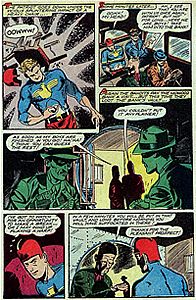

Interior page and panel detail from “The Patriot” story in
Marvel Mystery #62 (March 1945)
AB: That sounds about right. Maybe it was longer than I thought or maybe it wasn’t the first after all. It’s hard to remember. Anyhow, it was pretty crude. I was just starting to pencil.
MV: You drew in the Timely offices, right?
AB: Yes, I was a staff artist and Timely had a large staff.
MV: I’m trying to picture the work area there. How was it set up and who was sitting near you?
AB: Mike Sekowsky, Frank Giacoia, George Klein, Frank Carin…his name was Carino and he changed it to Carin, Chris Rule…
MV: Why did Frank Carin change his name?

Timely offices layout per Stan Lee
in Secrets Behind the Comics (1947)
AB: I suppose it sounded better without the “o” or it could have been a personal thing. Without knowing him that well I never gave it much thought.
MV: Was Rule there that early, in late 1942?
AB: I think he was. I could be blending the years here. Sekowsky, Klein, Carin and Giacoia were there at the beginning for sure. Ed Winiarski was also there that early on. Al Jaffee too.
MV: Was Vince Fago there? Fago became editor-in-chief during the war years when Stan Lee went into the service. This happened between the Feb/Mar 1943 cover dates, putting it at about Dec/42 real time.
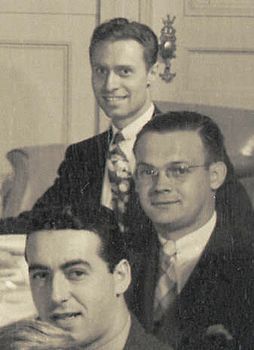
(from top) George Klein, Ed Winiarski
and Syd Shores (1942)
AB: Stan must have left within a few months of my starting at Timely. I recall he worked on wartime film strips out in Astoria, NY. I don’t recall him being sent overseas.
MV: He wasn’t. He worked on those army films as you say but was down south, I believe. Jim Mooney told me he once drove Stan’s old car down to where Stan was stationed and spent a weekend holed up drawing and Stan knocking out E. Claude Pennygrabber scripts for TERRYTOONS.
AB: For some reason or other I seem to remember Stan just always being there. I’m sure he was away, as you say, but my memory can’t pinpoint it. Perhaps because his scripts were still coming in, his presence was still felt there.

Stan Lee in 1942
MV: His name remained on the contents pages of the humor books so as you say, his presence must have still been felt.
AB: I do remember Vince Fago. He was a thin fellow with one eye that seemed clouded. Years later I worked for his brother Al. He may have acted as an agent for some publication but I just don’t remember the details. I recall doing one job that was about a devil. I was really happy with how the story came out. Usually, if I liked a script, I would put my heart into a story.
MV: What about yourself? Were you in the service?
AB: I went into the Navy in 1943. I was painting insignias in ships service. It was just a few months before I returned to Timely after receiving an honorable discharge due to illness. I notified Stan or Robby Solomon, I don’t remember who, that I was returning to Timely. It was no problem coming back.
MV: How was the staff set up in the Timely offices?
AB: There was a separation of the guys who worked on the adventure books from the guys who worked on the animation books.
MV: You mean the funny-animal books?
AB: Yes. We called them the “animators”. I remember one time Walt Disney sent them a letter telling them to stop copying their characters.
MV: Really? Were they actually copying Disney? I can’t picture any of their characters that might give Disney a problem.
AB: Well there were similarities, occasionally. I don’t think anything became of it because I don’t remember hearing about it again. I also remember the animators once made this moveable cartoon character which they manipulated from their room. They were crazy!
MV: Was there a lot of socializing among the staff?
AB: We used to play cards during lunch. Lunches were usually brought from home. Sometimes after hours we’d go out for a drink.
MV: What were the general working hours?
AB: About 9 to 5.
MV: Don Rico, as you told me, seems to have been used in some managerial capacity, evaluating new talent like yourself when you applied.
AB: Yes but he wrote and drew also. YOUNG ALLIES was one of his books. He had a brother Chester Rico who was a prizefighter. We used to go after work and watch him fight. There used to be a fight arena nearby, I’ve forgotten the name. Not Madison Square Garden, a local small Manhattan club arena. Some of these fights were televised and I would make sure I would wave to my wife and neighbors at home while attending these fights. I don’t think I ever remember Chester ever winning. Having one of the first television sets in the area, my place was always host to neighbors and friends. I lived on the ground floor and never closed the blinds while the TV was on. Neighbors were resting on my open window sill to watch the small screen. Martin Goodman called Don Rico “Rat Rico”.

Don Rico splash page for
Suspense #8 (May 1951)
MV: Why was that?
AB: Don and some of the other artists didn’t bother with Syd Shores who was the unofficial bullpen director. Rico was the ringleader of this “ignore Shores” group. He was always causing small problems in the office and Goodman knew this and hence the name “Rat Rico” he referred to Don with.
MV: Who were some of your biggest artistic influences at Timely?
AB: At Timely there was a guy named Tom Tomasch (sp?). He taught me a lot when I arrived. He was a short guy, very sophisticated and very nice. A real classy person. He even wrote a book on anatomy. He knew anatomy so well. He originally lived up in Lake Placid. His real name was, I think Elmer Tomasch but he was known as Tom. He would look over my work and correct me early on. Syd Shores was also a great help.
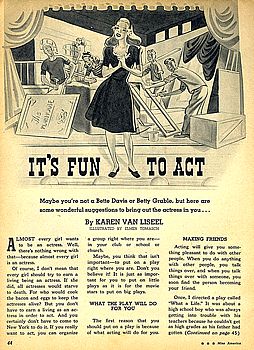
Elmer (Tom) Tomasch illustration from
Miss America vol. 1 #2 (Nov. 1944)
MV: Was Tom Tomasch an artist or production person?
AB: Tom was an artist and a darned good one at that. He knew his anatomy extremely well. He would make suggestions to me that helped me in my drawing.
MV: I’ve never heard of him before.
AB: I can’t believe how he’d get lost in the shuffle as he was so good an artist.
MV: I find it fascinating how many “new” Timely names are now being turned up after so much time has passed. Tom Tomasch is one. I’d never heard of Bob Deschamps until Jim Amash interviewed him. I’m betting there are even more guys who are not accounted for.
AB: I wish I’d kept records! Who would have known people would be asking about them 60 years later.
MV: I want to talk about two names of someone in management who I see all the time. I keep seeing him credit pages of the early funny-animal comics and it has always confused me. Was he an artist, an editor? I also keep seeing him in the credits of Martin Goodman’s magazine line. Who were Mel Barry and Mel Blum?
AB: Mel Blum was the art director of Goodman’s magazine line and pulp line. He was later divorced and we would bum around sometimes. We had that in common. Misery loves company, I guess. I remember one time he almost got us killed. We were out and he was falling asleep at the wheel of the car! Anyhow, he had a brother who was a photographer. His name was Barry Blum. Mel told me one time that he occasionally took his brother’s first name as his last name, as Mel Barry.
MV: Why?
AB: I’m not sure. I know he took jobs at some point with the NATIONAL ENQUIRER. Maybe he wanted to hide the fact he was Jewish. I just don’t know. I didn’t know he had anything to do with the comics though.
MV: He did at some point, at least early on. He’s listed as Mel Barry on the credits pages of early TERRYTOONS from Nov/42 through June/43. Then he’s listed as Mel Blum from July/43 through Sept/43 when the credits disappear. His title on these credit pages was “technical advisor”, which means nothing. He then continues as Mel Blum in Goodman’s detective magazines as “art director”. He followed Joe Simon as art director in those detective magazines. He also was art director on the celebrity magazines. I have him on these as late as the late 1950’s including a tenure as art director on a western digest published in 1956 and 1957 called WESTERN MAGAZINE. It basically was a small digest style western pulp with artwork by Carl Burgos, of all people. Mel Blum is listed on the inside front cover.

Vince Fago & George Klein drawn
credits page from Krazy Komics #3
(Nov. 1942)
AB: Yes, he was an art director. He was also a weight lifter could just about get through the door. He wasn’t that nice a person but I got along well with him. He was always full of puns and every time he pulled one his staff members would just walk away from him. He moved down here to Boca Raton with his second wife and we used to see each other. I haven’t seen him in years though and I’m sure he’s passed away by now as he was older than I was. He told me himself that he used his brother’s name. He was friendly when I saw him at Goodman’s after my divorce. I can remember him saying to me “Allen straighten up, you are walking with your head down”. At the NATIONAL ENQUIRER he made big money and worked for them for years. This was after ending his long relationship with Martin Goodman
MV: That must have been in the late 1950’s and he must have worked for the NATIONAL ENQUIRER even after that, perhaps in the 1960’s. But he was using Mel Barry as a name very early on.
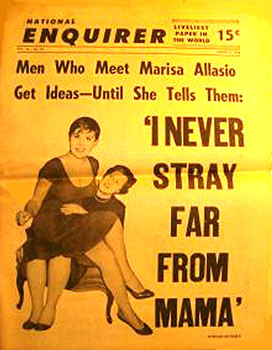
National Enquirer (March 9, 1958)
AB: Then I don’t know the reason. Mel Blum was Mel Barry and his brother was Barry Blum.
MV: Did Barry Blum ever work for Timely?
AB: I don’t think so. But Mel put out some of his brother’s work in other publications. Barry, like I said, was a photographer. I even posed for some of his pictures to be used on covers.
MV: Really?
AB: Yes, and he used to buy my cartoons to use in letters-to-the-editor columns, etc.
MV: What type of magazines were these?
AB: LOVE STORY was one.
MV: Who published that?
AB: He did, Mel Blum.
MV: Now Martin Goodman had a pulp line also.
AB: Yes he did, in fact I did illustrations for some of those pulps. I did them through Mel Blum.
MV: Why through Blum? He didn’t seem to be associated with the pulp line. In the late 1930’s, the editor of the pulp line was Charles Goodman. By the early 1940’s Robert O. Erisman took over and seemed to be the editor through the end. At different points Dan Keyes and the fictional Arthur Lane are mentioned in credits of the early 1950’s MARVEL SCIENCE STORIES but I’ve never seen Blum’s name in a Goodman pulp until WESTERN DIGEST and I’ve never seen an actual “art director” credit listed.
AB: Well as art director of the magazine line he also secured artwork for the pulps. I did these illustrations from home as a freelancer.
MV: I’ve seen quite a few pulp and magazine illustrations by Timely comic book artists. Simon and Kirby, George Klein, David Gantz, Frank Giacoia, Syd Shores, Al Gabrielle, Stan Drake, Mike Sekowsky and now I can add Allen Bellman. Timely cover artist Alex Schomburg also. And of course Frank R. Paul was a pulp artist who drew the cover to the very first Timely comic book. So there was obviously a lot of cross-over.
AB: Well it was extra money. Anyone would grab it. I remember one I did to accompany a boxing story in a sports pulp also.
MV: Martin Goodman had several sports pulps……BEST SPORTS, COMPLETE SPORTS and SPORTS ACTION, off the top of my head.
AB: I did some outside of the sports pulps, detective stories I believe. [Note: After this interview was conducted the author found a copy of the exact crime pulp Allen did the story illustrations for. It was for the very last issue(#26) Vol 4, #6 of DETECTIVE SHORT STORIES (Oct/47). Allen confirmed 2 illos he did, one of which was signed]
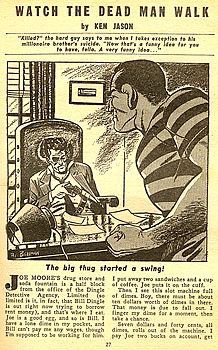
Bellman illustration for Detective
Short Stories #26, pg. 27 (Oct. 1947)
MV: How did your pulp freelance assignments come about?
AB: Like I told you, I was friendly with Mel Blum. He fed me those freelance assignments knowing I could use the extra money.
MV: How old were you when you got married?
AB: 20 years old.
MV: Right after you began at Timely.
AB: Yes. That marriage ended in a bad divorce and I’ve been re-married for 40 years now.
MV: Your wife Roz is wonderful. Especially how she puts up with all our hours of phone conversations! Do you recall a man named Bill King? He’s listed as an “associate” on 1942-43: books.
AB: He may have been the guy who took my Milton Caniff book. I loaned him or someone a hard cover Milton Caniff book in good faith. He refused to give it back!
MV: Why wouldn’t he give it back?
AB: He liked it so much he kept putting it off, making excuses, until finally I stopped asking him about it. I’ve never forgotten about it, though. I think he later came down with polio. I’m not certain it was Bill King but if Bill later had polio, it was him.
MV: So Caniff was one of your early art influences?
AB: Oh boy was he! He was one of my heroes! I used to eat, sleep and dream Milton Caniff. Every time the NEW YORK DAILY NEWS would come out, they had a morning and night edition sold for two cents, I’d cut out the Caniff and put it into a scrapbook. I started a cartoonist’s club in my Junior High School called The National Amateur Cartoonist’s Association. He was our honorary president. Boy, I started corresponding with him and when he started answering my letters I was in heaven! He wrote articles for us and we put out a little newspaper called the CARTOON JOURNAL. Some kids out in the Midwest printed it for us and we paid him 50 cents. He used a toy rubber printing set where every letter was set by hand. I was speaking to Michael Usulan about this recently. Michael wanted to know what Caniff wrote in my newspaper.
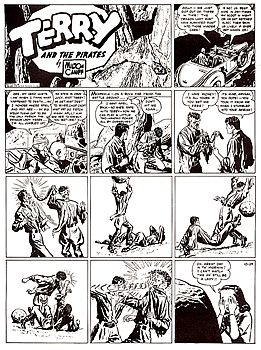
Caniff Terry and the Pirates Sunday strip
(Oct. 29, 1939)
MV: What did he write?
AB: In essence, he asked us to look around and see what was “hot” and take it from there, that we should be aware of what was popular at the time. It was written on pink stationary and in gray lettering. I ate, slept and dreamed of Milton Caniff. Years later I would meet Milton Caniff at the National Cartoonist Society Annual Reuben Award affair, held at the Waldorf Astoria.
MV: Did you say anything to him?
AB: Yes but it wasn’t what I’d hoped! I was waiting for my date outside the rest rooms in the Waldorf Astoria when Caniff came out of the men’s room. I approached him “Mr. Caniff”, I gave him the respect due him, and before I could even finish he said “excuse me, I have friends waiting for me”. I was wearing a tux same as he. I took a shower that day and changed my socks! Wow. What a letdown! My hero snubbed me!

Milton Caniff
MV: Many artists claim that Caniff influenced them greatly. Caniff seemingly influenced everybody.
AB: He was fabulous. Michael Usulan wrote the new TERRY AND THE PIRATES newspaper strip a few years ago. He’s a great Caniff admirer also.
MV: Do you have any existing copies of that Junior High paper?
AB: No. I don’t know what happened to them. Sadly, I never kept any.
MV: What about Robbie Solomon?
AB: Robbie Solomon was Stan Lee’s uncle.
MV: What was his actual position at the company?
AB: He was like a general manager. These guys came out of jobs like “shoe salesman”, etc., they had a relative in Martin Goodman and tried to get jobs. Solomon was a pain in the ass to the artists. His job was to annoy people (laughs). He was always on my back about something. When I joined Timely I thought he was the main guy running the office. He overshadowed Stan Lee and it took a while until I realized Stan was the editor. Robbie used to bring in comic books from other companies to show the Timely artists what he wanted. One of the artists was Lou Fine and this pushed me to change my brush strokes and put in more blacks. This improved my overall result. Robbie was always trying to act like he was running things and I recall he died a young death. Another person there who died young was a book keeper named Sylvia Fagan. She was a single woman who died young.
MV: It was Robby Solomon who originally got Stan Lee his job with Martin Goodman.
AB: I think I knew that but Stan Lee was much better to work for!
MV: What was the feeling at Timely of their hero comics compared to other company’s like National with Superman or Fawcett with Captain Marvel? Was there a palpable competition?
AB: They were never really mentioned, almost as if they were not a threat to Timely. Martin Goodman usually had more books by volume on the stands than anyone else. I remember Robby Solomon and Stan Lee telling the staff to draw like Lou Fine or Mort Meskin, not realizing that Timely magazines likely were outselling the competition or at least drowning them on the stands.
MV: Do you remember Gary Keller?
AB: Yes. Gary was a manager of some sort. He had glasses and walked around. My goodness, I haven’t thought about him in 60 years! This really takes me way back. While I can’t really put a finger on exactly what Gary did I do recall that he was a very nice man.
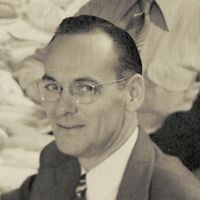
Gary Keller (1942)
Letterer and Head of Production
MV: What about Jack Grogan? I recall that he was a writer for a short time.
AB: Jack Grogan made up a sign when I went into the service. I think he lettered also. The sign said “We all agree that you’re the guy to knock the Axis for a loop. The best of luck to you old pal from all your friends at the Timely group!” Unfortunately, I think my ex-wife tore it up. It had all the signatures of everybody working for Timely at that time.
MV: That’s too bad. It would be wonderful to still have that! From I gather, Grogan developed drug problems and was later fired. Do you remember Ernie Hart?
AB: Sure I do. He had a mustache.
MV: Ernie also went by the pseudonym E.H. Huntley as his full name was Ernest Huntley Hart. He worked on and off for Stan lee through the 1950’s mostly as a writer and even came back in the early 1960’s during the Marvel hero revival. Early on in the Timely days he was a fine funny-animal artist.
Ernie Hart, circa 1942
AB: I told you that the animators were separated from the adventure artists. This is one of the reasons I didn’t get to know the funny guys that well. Another thing I want to mention is that there were a few artists working there who had mean streaks, or were just plain cruel. There was this young girl who worked in the office and every time she had to come into our room to give something to the staff these guys would get on her case making vulgar remarks. I remember how fast she would run out of the room. Then there was a young married woman by the name of Barbara who joined us an inker. The guys would sing “Barbara’s hole, Barbara’s hole” to the tune of the Barbersole Shaving Cream tune on the radio. Once they got on your case, they didn’t let go. This couldn’t happen today in an office.
MV: Unfortunately sometimes it does now but there are harassment laws now to help a woman.
AB: That’s true but they were isolated incidents and they stand out in my mind after all these years.
MV: Kin Platt? He was another humor artist.
AB: I remember the name and have a vague picture of him as tall and with glasses.
Kin Platt… and how he appeared in Secrets Behind the Comics
MV: Kin’s still around and about 90 years old. He’s out in California and had a long career authoring books for young people.
MV: What about Valerie Barclay?
AB: Valerie and I go way back. She went to the High School of Industrial Arts with me. I knew her well before my Timely days. She was called Violet back then but she was always changing her name. She was a bit of a loner who was always by herself. But she was an exquisitely beautiful young lady. She was a staff inker. I remember she would use India ink with a brush for mascara. That stands out in my mind. I remember she had a romance with Mike Sekowsky.
Rusty #18 (Aug. 1948)
[Platt / Barclay art]
There was a feud that resulted between Mike and George Klein that I believe was about over Violet. George was a nice quiet guy. I got along well with him. Years later, after the bullpen closed I met her on the street while I was hoofing it from publication house to publication house looking for work. We spoke a bit and made a date but I never kept it. This was right around the time I met Roz!
Valerie (Violet) Barclay entry inSecrets Behind the Comics (1947)
MV: So I guess she can’t read this, can she? (laughing).
AB: No! I’ll tell her the interview was never printed! (laughs).
MV: I met Valerie a few years back. We went out for some coffee and she allowed me to tape our conversation about her Timely years. A real charmer and still a stunner and impeccable dresser! The bad news is that after I got home I found out that the background noise in the coffeeshop completely obliterated all the spoken voices on the tape. It was completely ruined.
AB: I bet she told you a lot of Timely stories.
MV: I was interested in pinning down features she might have worked on but she was more interested in spilling Timely romance gossip. In fact, maybe it’s a good thing that tape is useless! And don’t worry, you were never mentioned!
AB: (laughing) That was a close one!
MV: Was there anyone else you went to school with who later worked in the business?
AB: Yes, there was another fellow there with us at school who while still a student did a Sub-Mariner story. His name was Mike Roy. He was looked upon as a big shot at school. He had done a “real” comic book feature! (Laughs).
MV: Mike Roy was drawing for either Goodman or Jacquet while in high school?
“Eustis Hayseed” page by Mike Roy
from Joker Comics #8 (April 1943)
AB: Yes and he was real good, much better than we were at that time.
MV: Mike Roy had a long career in comics.
AB: He was also over at Lev Gleason where he drew DAREDEVIL.
MV: Was that Sub-Mariner story ever published?
AB: I don’t know. I think it may have been. Chic Stone was another fellow Sam and I went to junior high school with. He later either worked on staff for Timely or freelanced, I don’t remember which.
MV: I’m going to run more name by you. Do you remember Fred Eng?
AB: He was a letterer.
MV: Marty Nodel?
AB: Marty was on staff for a while. In fact, I ran into him at a comic book convention in Ft. Lauderdale years ago. He lives in West Palm here in Florida.
“Eustis Hayseed” page from
Joker Comics #7 (Feb. 1943)
by Chic Stone.
MV: What about Al Avison and Al Gabrielle?
AB: They weren’t on staff when I was there. Either they predated me, were freelancers or worked strictly for Funnies Inc. and bypassed the staff completely in which case I would have likely missed them.
MV: They did early work on, among other things, CAPTAIN AMERICA after Simon and Kirby departed. That has me wondering about you mentioning that you did backgrounds for Syd Shores on CAPTAIN AMERICA.
AB: There were many CAPTAIN AMERICA artists as Timely published his stories in other books. Avison did them right after Simon and Kirby but Syd did some also. My first work was on those.
MV: Mike Becker?
AB: Mike I remember. We worked in the same room. He wasn’t too friendly and never said much except that he was a P.O.W. A private person.
MV: In addition to the staff artists, was there much work done by artists “not” on staff, meaning freelancers?
AB: Yes. There were many, many freelancers. Bill Everett was a freelancer. I freelanced my crime feature Let’s Play Detective while on staff. I wrote it and drew it all by myself. I created it. That was all extra money for me. Since I wrote it I was paid a scripting fee also.
MV: How did that come about?
AB: I knew that Stan needed fillers for the books so I went to him with the idea. It was my idea to have the reader turn the book upside down at the end for the answer to the mystery. Soon afterwards other magazines were doing the same thing and copying me! I’d see it all the time.
“Let’s Play Detective” from
Young Allies #19 (Spring 1946)
[this is the page Bellman is seen drawing
in photo at beginning of interview.]
MV: You mentioned Bill Everett but what about Carl Burgos?
AB: Carl at some point was on staff, maybe off and on, I don’t remember. While on staff he sat behind me. He didn’t speak too much and just did his work. We hardly spoke at all but I knew who he was and that he had created the Human Torch.
MV: Was there any freelancing outside Timely while you were on the staff?
AB: No, there was no time to solicit outside work. We did get a nice Christmas bonus every year, though. I eventually worked for Bob Wood
in CRIME DOES NOT PAY. Bob killed a woman, you know.
AB: It was in the NY Journal American. Bob was single. At Christmas time he used to have everyone up to his penthouse apartment. He threw parties and was a heavy drinker. He also used to come in on Mondays sporting a shiner and all bruised up. He must have fought often. He apparently had a woman next door that he knew and somehow killed her. I don’t remember the details. It was probably in a drunken rage.
Silver Streak #10 (May 1941)
with a Bob Wood cover.
MV: Who did you admire artistically at Timely?
AB: Syd Shores was extremely talented. Mike Sekowsky for certain.
MV: He was extremely versatile, wasn’t he?
AB: He was fantastic! Fast, free-flowing, just a natural talent. I didn’t like him too much as a person though. He had a terrible attitude and looked at people with contempt.
Mike Sekowsky from
Secrets Behind the ComicsMV: You’re not the first person to I’ve spoken to express such a sentiment. Everyone thought he was a fabulous artist but had a chip on his shoulder for some reason.
AB: He also had a brother who worked for Timely.
MV: That would be George Sekowsky. He did very little but I never knew he worked at Timely.
AB: Yeah he was an artist also. I don’t think he did much nor last too long there. George came to me to get him a television set one day. He gave me the money to buy it for him, knowing I was the only one in the neighborhood with a television. He wasn’t like his brother, he was easy to talk to, a nice guy. Is Mike still alive?
MV: No, he passed away in 1989, if I remember correctly. He had a very long career in comics drawing up through the 1980’s.
“Sub-Mariner” page by Mike Sekowsky
from Human Torch #31 (July 1948)
AB: At Timely Mike only penciled, never inked his work. He had a lot of different people inking him. It didn’t matter though, the end result was always good.
MV: Do you remember John Buscema at Timely?
AB: Yes. I am also sorry to hear that he’s recently passed away. John was a quiet kid, good looking with thick black hair. He was a really good penciller I recall. I don’t remember too much more about him. He wasn’t around too long. Another Italian fellow I remember much earlier was Carmine Infantino. He was friends with Frank Giacoia. It was Carmine who I remember telling me about this new young Italian singer who was appearing at the Paramount. That was Frank Sinatra! Carmine was a big fan. I like Sinatra a great deal also and his records helped me get through a dark period of my life during my divorce.
MV: Gene Colan?
AB: Gene was a young guy with lots of talent. He was quiet and laid back. Both John Buscema and Gene Colan were there towards the end of the staff’s life.
Human Torch #31 (July 1948)
[Gene Colan art]
MV: You mentioned to me once about Mickey Spillane at Timely.
AB: Mickey Spillane wrote quite a bit there. I remember the first time I met him. I had just finished up an assignment. I walked over to Stan Lee’s office and knocked on the door. “Come in,” says a voice from inside, Stan’s voice. There’s a GI standing there talking to Stan. Stan introduces me..“Allen, I want you to meet Mickey Spillane. Mickey, I want you to meet Allen Bellman.” I shook his hand. He had a crew-cut and was in an army uniform. Then Stan handed me a script to draw as my next assignment. In those days as soon as you finished one job you turned it in and was handed another script. Spillane had just brought it in and it was handed over to me. Mickey Spillane
MV: Do you remember what the feature was?
AB: Yes. It was a Jap Buster Johnson script. Even in those bullpen days, I often penciled and inked my own stuff. I remember that while I was inking it, I would use the script as an ink blotter to wipe off the excess ink. This totally marred the front page and then the script was tossed out at completion. Many times over the years I wished I had kept that script. A Mickey Spillane typed original script! Boy, who knew how famous he’d become!
In a similar vein of regret, when we lived in the Asbury Park section of New Jersey years ago my wife Roz helped book Bruce Springsteen for a teenager dance in the local community center, for which he was paid $400. She then interviewed him on tape for her weekly radio program called “Point of View” to help promote the dance. After the tape was broadcast she “erased” the tape! No one knew how famous Springsteen would become and this was all before his fame! But getting back to Mickey Spillane, in his ALTER EGO interview I think he denied that he ever wrote any war stories but he certainly did write that Jap Buster Johnson script I drew.
“Jap Buster Johnson” splash page
NOT drawn by Bellman
MV: Spillane came out of the Lloyd Jacquet shop, FUNNIES INC. That was one of the major sources that supplied Martin Goodman with features before he had his own staff and even afterwards. Carl Burgos and Bill Everett came from that shop. That’s where the features for MARVEL COMICS #1 came from. Prior to this Martin Goodman was strictly a pulp and magazine publisher.
AB: That all happened before I started at Timely. Bill Everett was a fine artist but I’ve never met him. I don’t believe he was on staff during any time I was there.
MV: Really? That’s fascinating considering how much work he did for Timely. Could it have “all” been freelance?
Daring Mystery Comics #7 (April 1941)
[Bill Everett art]
AB: Possibly. I want to digress here a minute. You asked about my earliest entry into the business. I once went for a job with my friend Sammy Burlockoff. He was also an artist and we were childhood friends. I think he’s passed away, a long time ago. We went up to FAMOUS FUNNIES and saw this man pasting down comic pages. This was our very first introduction to the business. I don’t remember his name but he was the guy who started FAMOUS FUNNIES. They were all reprints at that time.
MV: Was this before you answered the Timely ad in the newspaper?
AB: A few years before, we were about 15 or 16 and still in junior high school. We didn’t get the job but it gave us a taste of what the comic book business was like. Sammy and I were great friends [Note: As noted in the introduction, Sam Burlockoff is alive and well and as mentioned, thanks to Jim Amash, after this interview was given, we put Allen back in touch with his long lost pal.]
MV: As the 1940’s went on the super hero titles began to wane, especially after the war ended. Timely’s first change outside of the superheroes or humor books were crime books in 1947. Across the industry, crime titles really took off.
AB: They were everywhere and were extremely popular. Did you read the issue of ALTER EGO with the Rudy Lapick interview?
MV: Yes, I did. Do you remember him at Timely?
AB: If I remember correctly, he was the fellow who bought a wire recorder when they came out.
MV: I gather you’ve seen Bob Deschamps’ interview?
AB: Yes, in fact I remember him well now. In my mind I remember him as a young kid standing there waiting to take our food orders when he started. It’s impregnated in my mind. I took a look at his picture in the magazine, he’s about my age or so and there I see this young kid, his face clear as a bell. But Rudy Lapick, he mentioned me buying stock in plastics and that Sol Brodsky later told him I became a millionaire? I don’t remember that!
MV: Talk about Sol Brodsky. I know he was a close friend to you.
AB: Now there was a friend. Sol and I were close friends. We both lived in Brooklyn and I was already married. I can remember picking up Sol at his home (he wasn’t married as yet) and we went for a ride in my new car. I was a new driver and we were riding around the Prospect Park circle and I was scared stiff and frankly, I was driving blind! Even in those days traffic was heavy. I could hear horns honking at me and it’s a miracle that we made it back safely! When Roz and I were married we moved to the Jersey shore area of Asbury Park and Sol and his wife visited us often. He was a warm, good-natured person. His passing so early in his life shook me up. Strange Tales #9 (August 1952)
[Sol Brodsky cover]
MV: Bob Deschamps mentions your father’s bakery and that you would draw that bakery into the backgrounds of panels. Do you recall doing that?
AB: Sure! One time it was Martin Goodman’s birthday and I told my father to order up a cake to the office. Then I found out, or realized that no one would deliver it. I had to take the subway back into Brooklyn to get it and bring it in myself! Bob also mentions Murray Postel. Murray was Mel Blum’s brother-in-law. I say “was” because Murray was the brother of Mel’s ex-wife. Bob also mentions my Bell’s Palsy. I came down with that because I was always sitting next to the window in the Timely office. Bob Landers was sitting near me and always bugged me to open the window. This was in the Empire State Building and they didn’t have an updraft glass. There were fans going in our room and I can remember when Vince Alascia went to move the fan as it was blowing on him and accidentally cut his fingers on the blades. Landers always wanted the window open and then the window broke and was never replaced. The constant wind injured my facial nerve behind my left ear. There was no air-conditioning then and it was either the fans or the window. I recovered about 90% over the years. During the summer we worked a half day because of the heat so Syd Shores and I used to go to Ebbets Field to see the Brooklyn Dodgers play. Syd and I were very close. There was a camera store in the Empire State Building where we rented porno films and after work Syd and a few others stayed and when the others left we watched dirty movie. Even Martin Goodman would sit in! This was not a frequent occurrence, mind you.
MV: What about writers at Timely? You mentioned Mickey Spillane and we know Stan Lee also wrote but who else was there that you could recall?
AB: I remember Ray Cummings, for one.
MV: I’m glad to have that confirmed. Cummings was a pretty well known pulp writer at the time.
AB: I remember a story he wrote for CAPTAIN AMERICA that he took from one of his pulp stories, “Princess of the Atom’.
MV: Yes! That story is well known. A friend of mine, an excellent author in his own right and a fine comic book and pulp historian named Will Murray has postulated the same connection.
Ray Cummings’ two-part adaptation of his 1929 novel appeared in Captain America #25 & 26 (April & May 1943)
AB: Ray was an elderly gentleman and he always had his daughter with him who I think also wrote for Timely. He was always coming in and going into Stan Lee’s office for conferences and meetings. I guess they were story conferences. Syd Shores was frequently in on those meetings.
MV: Well that probably because Shores was likely drawing Captain America at the time.
AB: Syd Shores was a good friend of mine and a great talent. On the Westerns he drew the best horses of anyone on staff. It was a sad day when I attended his funeral in Morristown, New Jersey. Stan Lee and Martin Goodman attended and if I remember correctly they gave me a lift back to New York City so I could get the bus back to New Jersey. It was shortly after a bad auto accident where I had a leg cast on close to a year. I decided not to drive to the funeral.
MV: I think Syd was a fine artist and one of the most under-rated on comics. His Captain America was superb.
AB: After Simon and Kirby left (I never saw them there, they’d gone before I arrived) many people drew Captain America. I think I remember Fred Bell was one, perhaps Al Avison also, although I never saw him. But Syd Shores was the main Captain America artist throughout the 1940’s. Vince Alascia was his primary inker, I’m certain. Vince was a very nervous type of guy and he inked in that manner, in very short strokes.
MV: Did Ray Cummings and his daughter work in the office or did they just come in to drop things off?
AB: They came up to discuss matters but that’s all I remember. I never saw them working in the office. I remember them very clearly there.
MV: Did the artists and writers have a lot of contact with each other in the office?
AB: No, except in certain circumstances like I mentioned where Ray and his daughter would confer on a story with Syd Shores. I also know another writer you may not know about?
MV: Who?
AB: My cousin, Leon Bellman. He also wrote for Timely.
MV: You’re kidding?
AB: No, it’s true. It was only for a short time. He floated around after school from job to job. He then got this urge to become an opera singer and was tied in with the Metropolitan Opera. He also went to Italy to study opera singing for a while. He never stuck to anything. I encouraged him to write and he landed work at Timely and was doing pretty good.
MV: How long did he work there?
AB: I don’t remember exactly, not too long though. I also cannot for the life of me recall what exactly he wrote. But I can tell you he wrote for Timely in some capacity because I got him the job. He was about 6 years older than I was, born in 1918. I also remember Bill Finger at Timely.
MV: This takes us back to Bob Kane and his arrangement with National. Finger wrote for Timely in 1946 only on all their major characters, Captain America, Sub-Mariner and the Human Torch. He wrote the All Winners Squad also. This must have been some freelance work for him because he spent just about his whole career writing for National. Finger never got the credit for his role in the early Batman co-creation. Somehow Bob Kane was able to cut him out of the history. He later spent a lot of time writing for television in the 1960’s.
AB: There was also a husband and wife team writing for Timely that I remember. Bill and Dorothy, I believe.
MV: That would be Bill and Dorothy Woolfolk. Bill just recently passed away this August. Dorothy was an editor when Vince Fago was chief, while Stan Lee was in the service. Bill met Dorothy there.
AB: If I remember correctly, Bill had a slight Bell’s palsy like I did.
MV: Maybe it came from the same window draft! William (Bill) Woolfolk
AB: (laughs) No, he had it already, I believe. Bill and Dorothy seemed to work as a team and I never knew if they were freelancers or worked on staff. I remember there was one writer who sold his same script to many different comic book publishers, just changing the names of the characters.
MV: Did he get away with it?
AB: No, he was caught! I also remember doing a baseball story written by a woman who knew nothing about baseball. She had the manager taking a pitcher out of the game and then bringing the same pitcher back into the game. It got past Stan!
MV: What about a woman named Patricia Highsmith? She was supposed to have written for Timely.
AB: No, I’ve never heard of her. Don Rico wrote quite a bit and later on Al Sulman also. I can’t remember who else. Getting away from the comics division, I remember Bessie Herman Little as the editor of Martin Goodman’s movie magazines.
MV: Bessie Little, from what I’ve gathered, actually created the character of Patsy Walker for the second issue of MISS AMERICA which was the first girl’s magazine type issue. The first issue was a comic book.
“Patsy Walker” from
Miss America vol. 2 #5 (Aug. 1945)
AB: She also had an assistant, a young girl who walked with a limp. This young lady was president of the Eddie Fisher fan club and wanted Fisher to take her out. When he refused she became angry at him and that was the end of her being president. That young lady grew up to become a famous movie commentator whose name escapes me. Rona something.
MV: Rona Barrett?
Rona Barrett
AB: Yes! That’s her. This info came to me from Mel Blum. One day she came in and asked me if I wanted to join her as she was going to interview a new movie starlet. I couldn’t go but the name of the actress was Shirley Shrift who changed her name to Shelly Winters. Later on Bessie was publishing comic books with a cartoonist from the defunct NEW YORK DAILY MIRROR. The first job I did for her I got stiffed as I had with Fox publications one time. I was warned about Fox not paying so I went in with my eye’s open. Mario Puzo also wrote for Goodman’s publications, not for the comic books. Mel told me they paid him $35 a story or page, I forget which. I also remember actress Ann Rutherford coming to our office or rather to see Bessie who was editor of Goodman’s movie magazines. When she left I made believe I was going to the men’s room as I wanted to ride down the elevator with her. We spoke a few words. She was Mickey Rooney’s girlfriend in the Andy Hardy movie series. She also played in “Gone With The Wind” as one of Scarlet’s sisters.
MV: Anything or anyone else stand out about your Timely days?
AB: Outside of people I worked with, I remember someone on staff or a freelancer coming into our office saying that someone told him that we had a secret weapon that would end the war. Sure enough a short time later the atom bomb was dropped on Japan. I remember seeing a shoe falling down (I sat next to the window) of a man who committed suicide at the Empire State Building and him landing on top of a parked car belonging to a diplomat. The roof of the car was crushed in. I remember when the plane hit the Empire State Building on a Saturday when we were off.
MV: You fellows seemed to enjoy your workday.
AB: Any day could be an adventure. Like I mentioned, you never knew what movie star would visit the office because of Martin Goodman’s movie magazines. Goodman also produced a Broadway play that bombed after one performance. Once there was a cocktail party at the Ritz Carlton hotel. I met child star Jane Withers, the late Carol Landis and others.
MV: Let’s change direction again. What about Artie Simek?
AB: I remember the very day Artie Simek came to work for Timely. He gave the impression that he just came off the farm. A real hayseed. He was tall and lanky and really didn’t say very much. This was his very first day and come lunch time some of the staff took out a deck of cards so they could play as the munched on their lunch. Not Artie, he pulls out a harmonica and starts to play. I don’t remember the tune but it took us all by surprise. He played it quite well.
MV: What year was this?
AB: About 1946 or 1947. Artie was a good soul. He never bothered anyone and did his work well. I’m sorry to hear that he too has passed on. His wife’s name I believe was Emily, who passed on before him if my memory serves me correctly.
MV: Do you remember any other letterers?
AB: Bob Landers was a letterer who sat opposite me. There was a time that the office did not have airconditioning and I always sat next to the window. Bob used to open it all the time and the wind blew in my ear constantly and caused my Bell’s Palsy.
MV: Do you recall Irv Spector at Timely? He didn’t do that much there, just a handful of features and spot illustrations for the MISS AMERICA title for teen girls
AB: Oh yes. Irv Spector worked for Timely and then went over to Lev Gleason. I worked for Gleason when the Timely staff was disbanded. I then joined the Lev Gleason staff. Spector became the editor and later went on to Hollywood. I did quite a bit of freelance work for Irv at Lev Gleason also.
MV: He made a mark in animated cartoons.
Krazy Krow #1 (Summer 1945)
[Irv Spector art]
AB: Yes, I saw his name on a Bugs Bunny cartoon once.
MV: The only feature I ever saw him on at Timely was a funny-animal feature called Little Lionel that ran in KRAZY KROW #1 (1945). He signed it in tiny letters “Spect”. I spoke to his son once about this feature and his son couldn’t believe it. He had no idea his dad was at Timely at this time and told me it must have been the first job he took when he got out of the service.
AB: Well a lot of things get left out of comics history. That’s why these interviews in ALTER EGO are so important. We’re all very old and many of us are gone or will be going soon. Not to be morbid but I’ve been waiting 50 years to tell my story. I didn’t even know there were magazines that were interested in this stuff. It’s very gratifying to be remembered for what we did so long ago. I want to make my story as accurate as possible.
MV: And you’re doing a wonderful job!
AB: I ended up doing some freelance work for Irv Spector at Lev Gleason but then they let their staff go also. Sometimes I wondered if there ever was really a “Lev Gleason” because in all the time I was there I never met him!
MV: Was he hiding? (laughs)
AB: Bob Wood, Charlie Biro, Martin Goodman, I knew them all.
MV: But not Lev Gleason?
AB: No, not Lev Gleason. Did he exist?
MV: As far as I know, yes. He was the publisher and put the crime line together with Biro and Bob Wood. I think he even offered them a percentage as incentive.
Charles Biro from
a 1937 promo flyer
AB: I worked on staff there drawing for books like CRIME DOES NOT PAY and he “never” was in the office. I knew both Biro and Wood well.
MV: I can’t explain that. Now in 1947 Timely began to branch out. Up to this year the only types of comic books they published were super-hero titles and funny-type humor titles. With the decline of super-hero sales after the war, the first “new” type of books they produced were crime comics, copied from Lev Gleason’s crime books that were on the stands since 1942. Martin Goodman finally caught on by the start of 1947 and they put out JUSTICE COMICS and OFFICIAL TRUE CRIME CASES. What do you recall about this change by Timely?
Crime Does Not Pay #52 (June 1947) Official True Crime Cases #24 (#1)
(Fall 1947) [Syd Shores cover]
AB: I remember that during the war I was drawing The Patriot feature. As soon as the war was over, so was The Patriot! So I knew that super-hero features were stalling. Martin Goodman was no fool. He had a huge publishing empire outside of the comic books. He was always studying sales figures in his office. The Lev Gleason crime books were very popular and I’m surprised it took as long as it did for him to try something new. The Lev Gleason books had those Charlie Biro covers! They were great!
MV: Why do you think the hero titles waned after the war?
AB: I’m sure the public was sick of heroes fighting Nazi and Axis villains. While the war was on it was good propaganda. When the true horror of the Nazi regime was exposed to the world it likely made super-heroes seem silly in comparison. Perhaps the public wanted more realism and the crime books attempted to give them this realism. Also at this time crime films were in vogue and Hollywood’s biggest stars, Cagney, Bogart, Eddie G. Robinson, all were headlining gangster films. It’s normal for comic books to follow that trend. It seemed a natural progression. Some of them were very violent.
MV: Martin Goodman had also been publishing three true-crime type magazines for almost a decade, AMAZING DETECTIVE CASES, NATIONAL DETECTIVE CASES, EXPOSE` DETECTIVE and COMPLETE DETECTIVE CASES.
AB: And also crime pulps since the late 1930’s.
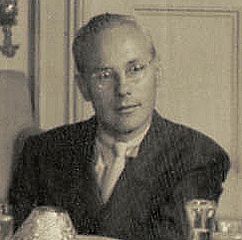
Martin Goodman in 1942
MV: That’s true. What about sales across the board at this time? It’s long been known that some of the biggest sellers were the teen girl type comics. MISS AMERICA allegedly sold in the millions. Did they outsell the hero titles?
AB: During the war I think the hero books were tops but right after I’d bet the girl books overtook them. The artists on them took the books very seriously because they were such big sellers. There were so many of them. MISS AMERICA was a copy of SEVENTEEN MAGAZINE. Timely wanted to tap into that audience. But by the end of the decade the crime books may have overtaken both. Crime became enormously popular. There were many other titles similar to the two you mentioned that Timely put out. But I never saw actual figures. I have no idea what the numbers were.
Miss America vol. 7, #39 (May 1951)
MV: Many of the artists drew both types of books. Dave Gantz drew teen and hero books.
AB: And Mike Sekowsky. He drew both and drew them well. He was the best artist Timely had, bar none. He drew everything and drew it fast. His pencils were loose, flowing and exciting.
MV: Yes. Mike Sekowsky, equally at home drawing The Human Torch or Georgie!
AB: That was Mike!
MV: What do you recall about the disbanding of the Timely Bullpen? There have been conflicting stories about that.
Georgie #10 (.April 1947)
[Sekowsky/ Giacoia art]
AB: Here’s a story about that. They put up a speaker outside of both rooms that housed the artists, about 1949 or so. We called it the “bitch box”. Every so often you’d hear Stan yell “so and so come into my office” and you’d know that “so and so” was being fired. It was the voice of doom. I was a bit of a wiseguy and I used to say out loud “I’ve seen them come, I’ve seen them go.” I said it over and over with each person called in because for some reason I felt very secure. Then one day I heard “Allen Bellman, come into my office.”
MV: What exactly did Stan say?
AB: I don’t remember. I blanked it out. The details are all blurry now. I knew they were disbanding the staff slowly. I’d guess this was late 1949.
MV: Why were they disbanding the staff?
AB: Well they were cutting the fat. They took inventory and saw they had a lot of work stored. Goodman, Robbie Solomon, Stan Lee, they were all involved in that.
MV: That dovetails with Stan Lee’s story of a closet full of inventoried artwork.
AB: Anyhow, as I passed the “bitch” box outside Stan’s office on my way out, I hear someone say “I’ve seen them come, I’ve seen them go.” (laughs). I can laugh about it now but I wasn’t laughing then.
MV: So from what you remember the staff was let go slowly over time?
AB: Yes. I was fired about midway through the entire staff firing.
MV: The truth is possibly somewhere in between. Martin Goodman probably took inventory, found a large surplus and instructed Stan Lee, his ax-man, to fire the staff. Stan being close to you guys probably slowly disbanded the staff one at a time over a longer period.
AB: But I was lucky because I got a job right away with Lev Gleason. Charlie Biro and Bob Wood were there.
MV: So you go over to Lev Gleason and join their staff for a while until they disbanded also. Was the Lev Gleason staff different in make-up from the Timely staff?
Crime Does Not Pay #99 (June 1951)
AB: It was smaller. There were just a few artists on their staff and it was nice working there. Bob Wood never really bothered anyone and Charlie Biro was in and out of the office, “out” mostly. I remember I and the staff, along with our wives, being invited to Wood’s penthouse for a Christmas party. I also did some work for Will Eisner in his office. When Timely’s staff ended I found myself knocking on his office door. He gave me a script to do with the understanding I would do it in his office, which I did. He stood over me and wanted me to draw in his style. That was like telling someone to change their style of writing to fit “your” style of writing, or making a left-handed person write with his right hand. I “did” learn a lot from him.
MV: Shortly you were back freelancing for Stan Lee in early 1951.
AB: Yes, Stan fired us but Timely still needed new work. The funny thing is that almost everyone that was fired was back freelancing almost without a break! When Lev Gleason disbanded the staff I was back at Timely and Stan Lee was feeding me scripts again. The only difference was now I could work at home. One day a neighbor knocked on my door saying he wanted me to loan him one of my pages as the other neighbors couldn’t understand why I was home all the time.
MV: You were freelancing horror stories, westerns and crime stories. In 1951 Stan tries to do a continuing character feature outside of the girl, super-hero or western books and puts out a new sci-fi series done up in a Buck Rogers fashion. This book is called SPACE SQUADRON and features Captain Jet Dixon of the Space Squadron.
AB: Yes.
MV: What are your recollections?
AB: I wasn’t the first artist on that feature.
Space Squadron #5 (Feb. 1952)
[Sol Brodsky cover]
MV: No, George Tuska was the first, then Werner Roth after him. Why did those guys only draw an issue or two and leave?
AB: It was just another assignment to them. Whoever walked in would get it unless you were doing something really special. Sometimes you would just find work someplace else and take whatever is offered. Freelancers live a desperate kind of life.
MV: By issue #5 you become the artist. You drew 3 stories in #5 cover dated Feb/52. Then with #6 the title changed to SPACE WORLDS and you drew 3 more stories. There were also sci-fi type fillers by guys like Joe Maneely, Chris Rule and George Klein.
AB: I thought I drew more than 2 issues.
Space Squadron #5, pg. 1
(first story)
MV: No, if you did they were never printed but would likely have turned up somewhere as fillers in another book, which they didn’t.
AB: It may have seemed like more because I remember that I shared space at that time. I lived in East Meadow, Long Island and shared a studio with Syd Shores in Hempstead. We shared this studio for a while and split the rent.
MV: Do you remember how you got this feature assigned to you?
AB: Basically, I went in for a script and that was the next one!
MV: Nothing else special? You weren’t told that this was a continuing, ongoing feature?
AB: No. Still, I could swear I did at least 3 issues!
MV: Only two for certain. There was a back-up feature called Blast Revere that George Klein drew. Chris Rule also drew a feature called Famous Explorers of Space. It was a neat little title.
AB: I’m glad you liked it.
MV: You signed most of these stories but Klein and Rule didn’t. Any idea why?
AB: I was always made to feel that Timely didn’t want you to sign your work while you were on staff. If you notice, I always signed my freelance work very small. I think Chris and George were just used to never signing their work.
MV: Well I can only think of a tiny handful of times I’ve seen Chris Rule’s signature and I’ve only seen George Klein’s name attributed on a handful of very early Timely features in 1942. The pattern seems to be they signed “very” early on, 1939-43, then most signatures seemed to vanish through the 1940’s, making art identification a real difficult endeavor and then not really return until after the freelancers started in 1950-51. Guys like Bill Everett and Carl Burgos seemed to sneak signatures in and of course Stan Lee signed “everything” he wrote.
AB: He was the boss. He could do anything he wanted!
Junior Miss #26, pgs 24-25
(Sept. 1947) [a rare signed
Chris Rule illustration]
MV: Was there a stated policy on signatures?
AB: No, not that I ever heard. We just did what the others were doing. It was hearsay. I also remember being told that they didn’t want other publishers grabbing you.
MV: I’m going to throw more obscure Timely names at you. Stan Drake.
AB: A great artist. I have no recollection of him but from what I understand he worked for Timely in some capacity early on.
MV: He did a few early features and then did a lot of early pulp illustrations. What about Bill Walton?
AB: I knew Bill Walton well. He also worked with me at Lev Gleason. A short Irish fellow.
MV: His unsigned Timely work has always eluded my identification. More than one person has placed him at Timely and I’m happy to have you corroborate it. What about Harvey Kurtzman?
AB: Kurtzman freelanced for a short while but I didn’t know him. He went over to EC. I have a story to tell you about Al Feldstein.
MV: Please do.
AB: One time, I forget the exact year, I was finishing up one of Stan Lee’s freelance jobs when I received a call from Al Feldstein, whom I had never met. He wanted me to come down and pick up a script immediately. Whether I should have dropped everything or not I don’t know but I told him that I “had” to finish this job first for Stan as there was a strict deadline. I told him I could pick it up tomorrow as I was dropping off the story with Stan. He finally relented, saying I could finish what I was doing, and I went down there the next day. It was too late. He had given it to someone else. I’ll always regret not jumping at that chance.
MV: Where did he get your name and number from?
Al Feldstein, circa 1950s
AB: I had stopped up there in the past, leaving samples, etc. They had taken down my name and number but I hadn’t met Feldstein when I was there. I just left the samples with the secretary.
MV: Wow! What a missed opportunity. E.C. had a small but extremely talented staff. You should be honored to be considered. Al must have liked what he saw.
AB: I like to think he did but in retrospect, I wasn’t as accomplished as they were.
MV: Joe Giella was on the Timely staff, wasn’t he?
AB: He was an inker who was very quiet as I remember him. I think he later did Mary Worth in the newspapers.
MV: Among other strips as well as a long career for National. I have another obscure name from Timely’s past, Frank Torpey.
AB: I remember Frank very well. He was always moving very fast, like The Flash. He ran in and out of Martin Goodman’s office conducting his business. I never knew exactly what his business was. Where he came from and where he was going was a mystery to me. I once thought he was a messenger person!
MV: Frank Torpey was the man who convinced Goodman to start publishing comic books in 1939. He was the Funnies Inc. sales agent for Lloyd Jacquet. If you remember him it must have been early in your Timely tenure while Goodman was still buying Funnies Inc. features. As I think about it, he was doing so concurrent to the operation of the bullpen staff for a while so maybe it’s not so strange after all.
AB: I saw him around the offices quite a bit and like I said, I never knew what he did.
Frank Torpey (1942)
MV: You seemed to vanish from comic books in 1953-54. Although you missed the formation of the comics code, did you hear about Dr. Wertham and the senate hearings on the ills of comics?
AB: I did hear that there was a group of crusaders trying to destroy the comic book industry. This was in the newspapers and in the news on radio. I never thought they would succeed. I never paid too close attention once I was out of the business although they almost made comic books a thing of the past.
Seduction of the Innocent
by Dr. Fredric Wertham (1954)
MV: They did succeed in driving out many publishers. Bill Gaines’ line was decimated and he was almost driven out also. He hung onto MAD and turned it into a magazine. It became a goldmine. How did your retirement from comic books come about?
AB: By that time I was divorced. When comics started to slow down in the mid 1950’s I got a job with Pyramid books on Madison Ave. There I learned layout and drew a lot of cartoons for them. But before that I couldn’t seem to get any more comics freelance work.
MV: That surprises me a great deal because while comic books were under fire and many publishers were going under as the comics code came down in 1955, Goodman actually “expanded’ his line. He continued to publish a ton of books and continued to buy a vast amount of freelance work. There certainly should have been enough freelance work for you.
AB: Well I had a lot of things going on in my life and it was not a good time for me personally. Maybe that was the reason. It’s been so long now. I went through a very bitter divorce and my mind was probably not focused. I was just floating around, going from job to job. There was a publisher on 14th street, a real schlock operation. I worked there for a while. But then I got that job with Pyramid books. They published paperbacks. They also had a men’s magazine and I learned and did magazine layout as well as cartoons for them. I also drew the cover and many interior illustrations for a paperback called IMPOSSIBLE GREETING CARDS.
Impossible Greeting Cards (1957)
MV: What year was that? Do you have a copy of it?
AB: It was 1956 or 1957. No, I don’t have a copy. My wife has never seen it either. [Note: Allen had not seen a copy of this book in 45 years. I located one and sent it to him after this interview was given.]
MV: What was the name of the men’s magazine?
AB: I think it was MAN’S MAGAZINE or something similar. I remember they had an article on Rocky Marciano in one issue. I was newly divorced and went up to Grossinger’s, a country club. Rocky Marciano was there and I told him I worked for the magazine that just did a story on him. His manager was there and told me in no uncertain terms how unhappy he was with the piece. What could I say? Then a few months later I was walking to work and was in front of St Patrick’s Cathedral on 5th Avenue and I see Rocky Marciano walking right towards me on the street. He was carrying a small gym bag with him. He recognized me stops to talk for about 20 minutes. I ended up late for work but who cared! I’ll never forget that. He was a kind, soft-spoken person. I remember I had one of the first televisions in my neighborhood in Brooklyn and I saw Marciano knock out Joe Louis at the end of Louis’ career. Everyone was always over my place to watch television. I had no control over my own apartment! (laughs).
Allen Bellman and his television make an appearance in a “Jeannie” story from
Margie Comics #49 (Dec. 1949).
MV: Marciano died tragically.
AB: Yes, in a plane crash but that was long after he retired. I felt terrible about it. And Joe Louis was an American icon. He was hounded for years by the IRS for money he didn’t even have. He was taken advantage of terribly. But getting back to comics, one time I also went over to the Associated Press and they liked my work. I was a copy boy there as a kid. You may ask what a copy boy is. There is no such thing anymore but we watched the ticker tape machines which spit out the news and it was out job to distribute the tear sheets among the writers or reporters. I worked in the RCA building from 12 midnight to 8 or 9 in the morning at the tender age of 17. In our break or supper time hour the other copy boys and I would sneak out onto one of the roofs to join the reporters from the Tass news agency or Reuters news agency, who were into the “going ons” in the residential building across the street! Anyhow, the A.P. was looking for an artist to take over the comics strip Scorchy Smith and sent me over to a Mr. Wing, a bald-headed guy. I’ll never forget him. I had my portfolio and he liked my work a great deal and wanted me to do a week’s worth of sample strips. 6 dailies without a Sunday. I was very happy but had no one to share it with. I did a single daily and I couldn’t go on. Doom and gloom had set in. Every comic book artist dreamed of doing a syndicated newspaper strip. That was the ultimate. I was still living with my ex-wife and I became afraid that I couldn’t do it. My home life was terrible in my first marriage and I was afraid to take on the responsibility. My mind was not free of stress and one had to have a free mind to write and illustrate a daily strip. If you sign a contract you have to deliver and I lost my confidence and gave it up. Stan Lee was keeping me busy with freelance work and this was keeping me alive. I was living with a woman who tore up my finished freelance work when we got into an argument. If I had had a wife like Roz at the time it would have been a completely different story.
MV: What a shame.
AB: It really was. That period of my life was shattering emotionally for me. I was floating around in a fog and missed many artistic opportunities to move up. I went from being a hot-shot comic book artist with a wife and 2 children and then it was gone. Maybe if I was married to the right woman at the time I would have stayed in comics or at least in the art field. If only I had met Roz at the time of my first marriage. No, but that wouldn’t have worked as I was 20 at the time and Roz was only 10! (laughs).
MV: One of my favorite Atlas horror stories that you drew was called “Vampire Brats”.
“Vampire Brats” last page
Adventures Into Terror #4 (June 1951)
AB: That was the story where I put my daughter Judy, who was 3 years old at the time, into the last panel. She had cute pigtails! She was the “vampire brat”! Years later she was married to her first husband, now deceased and she called me up excitedly telling me her husband had found a copy of the issue containing that story. He then put it into a trunk with a ton of other comic books and could never locate it again. At that time I had no copies of any of my comic book work and was dying to find some to show my wife Roz and my children, who had never seen it. It was very discouraging. But then you tracked me down and sent me hundreds of pages. I cannot “ever” thank you enough.
MV: Allen, the pleasure is all mine. I’m just grateful to be able to give something back to you.
AB: Well I always tried my best. What troubled me for so long was the fact that my wife Roz and her 2 children that I adopted had never seen my work. I used to go to comic book stores and flea markets and one time there was a convention in a town nearby but no one could help me and to make matters worse, no one even heard of me. It made me almost feel that I never really was a comic book artist. You’ve given that all back to me and especially to Roz. It’s given my life and my later years a new fulfillment.
MV: Roz is a real sweetheart. When you came up north last year and we went out to dinner she was the loveliest and most gracious host I could imagine. She spent more time doting over my children than she did over you!
AB: That’s my Roz!
Roz and Allen
MV: Were you aware that Goodman almost went under in 1957 when his distributor collapsed?
AB: No. I was so wrapped up in my own problems that nothing else mattered except my will to survive.
MV: Did you know that Stan Lee later had a huge success with Jack Kirby as they revived superheroes in the early 1960’s?
AB: Again no, not really. I repeat. The life of living alone was not for me. I was wrapped up in my own problems and not aware of what was going on in a business I had left years before. I wanted to settle down again and my focus and attention was on that.
MV: Have you kept in touch with Stan Lee over the years?
AB: Yes. When people learn that I worked for Stan they ask me if I could get his autograph for their kids. Kids my eye! I think they wanted it! Stan never let me down. I remember when this friend asked me to get Stan’s autograph for his four kids. I told him that he was asking too much and that I couldn’t impose on Stan. Stan never just sent his John Hancock. He always included a small gift along with it like a Spider-Man book or hat along with his signature written on the visor of the cap. It always included a hand-written note to me along with it. So when he sent me the four autographs and the goodies that went with it, he wrote back “I’m glad your friend doesn’t have 12 kids”. Stan is a “mensch”, a Yiddish term for a good person.
Stan Lee and Allen in 1992
[The following part of the interview was conducted “after” Allen was told that his friend Sam Burlockoff was alive and well, having been interviewed independently by Jim Amash for this very same issue!]
MV: I want to talk about Sam Burlockoff a bit. How far back did you guys go?
AB: Sam and I went to junior high school together in the Williamsburg section of Brooklyn. That’s where I bought that first issue of ACTION COMICS in a candy store near the school on my lunch hour. Sam always told me that I was the one who got him into the comic book business. I mentioned to you earlier how one of the very first things we did concerning the publishing world of comics was when we went up to the FAMOUS FUNNIES office while still in junior high. They published reprints only at the time and I don’t remember who the guy there was but he was pasting down strips while we were there. We didn’t get any work from him, not even a gopher job. Sam and I were great friends. When I went over to his mother’s house I ate kielbasa. When he came to my house he ate my mother’s pickled lox. We were very close. One time Milton Caniff was going to make an appearance on radio on WOR. There was no television then, only radio. The name of the program was The Benay Venuta Show. We didn’t have tickets and went pretending we had them. The studio was on 42nd street in the New Amsterdam Building. We were last on line to get in and when we reached the ticket taker we started an Abbott and Costello routine of each of us thinking the other had the tickets. Finally the ticket taker says “Ah, just go in!” (laughs).
Benay Venuta
Singer/actress of the 1940s-50s
MV: Not a bad idea. I should try that sometime.
AB: We wanted to see Caniff so badly. We’d do anything to get in. he was our hero.
MV: When you started at Timely, Sam didn’t go with you?
AB: No, by that time we had drifted apart as people do after school ends. I was single and saw that ad in the NEW YORK TIMES that Timely was looking for a background artist.
MV: I wonder how many other staff artists came to Timely by the same ad?
AB: I don’t know but as I mentioned, I have my late father to thank for it. I didn’t want to go and I thought the office would be closed on the holiday. I don’t know what I would have ended up doing for a living if he hadn’t pushed me. I still don’t know what Don Rico saw in me. I had no experience at all.
MV: They needed anyone who could hold a brush. A lot of that early Timely work is crude, as was much of the work around the business. There were a lot of talented artists though.
AB: I started out as crudely as you can imagine but I learned fast on the job. Guys like Mike Sekowsky and Syd Shores were fantastic artists even as young men. I was never in their league. But I never knew what happened to Sam. Many years ago my ex mother-in-law told me a friend of mine from the neighborhood passed away. I was sitting alone at the airport waiting to pick up my children. My ex-wife had re-married and her husband was there. My wife’s mother said it was my friend with the bushy eyebrows, which Sam had.
MV: So you just assumed it was Sammy.
AB: Yes and I’ve thought him passed away for 45 years. I had tried to find him over the years to no avail so I assumed it was him she was talking about.
MV: A few years ago you mentioned him to me when you told me the FAMOUS FUNNIES story and I sent you photocopies of Timely stories he did in 1953 and 1954, just after you left comics.
AB: I had no idea he had later worked for Stan Lee as a freelancer and was thrilled to see those copies.
MV: Then last year Jim Amash asked me if I had ever heard of an artist named Sam Burlockoff because he was interviewing him for ALTER EGO and I froze. I told Jim he was a childhood friend of Allen Bellman and that you thought him long deceased.
Allen and Sam Burlockoff reunion in 2003
AB: Michael, when you called me and told me to sit down I thought you had bad news.
MV: I knew you would but I had to heighten the suspense!
AB: Then you told me he was alive and well and gave me his phone number and tears came to my eyes. First you gave me back my old comic book legacy and then you give me back my old friend.
MV: You can thank Jim Amash, Roy Thomas and ALTER EGO, Allen.
AB: I do, dearly. And he lives right down here in Florida. We drove out a few months ago and had a just wonderful time together. He didn’t look like the Sammy I remember but he sure sounded like him! Sam told me that our old schoolmate Mike Roy worked with him in Washington D.C. drawing propaganda comic books which were printed in Russian and Japanese and working under Edward R. Murrow. Sam said Roy called him from Washington saying there was an opening for an artist. Sam agreed to move his family lock, stock and barrel to the nation’s capital for that job.
MV: Anything we’ve forgotten to talk about?
AB: We’ve covered so much. I don’t think I mentioned that I was a member of the National Cartoonist Society. I was sponsored by Henry Boltinoff, a gag cartoonist and Al Smith, who did Mutt and Jeff. The acceptance letter was signed by Dik Browne. I’ll relate another story. A while back Roz and were invited to a cocktail party at the cartoon museum in Mizner Park here in Florida and saw Mort Walker. He had written a hard cover book about his life and it was just out. Now let’s back up a good many years and I mean “good many”.
I was about 11 or 12 years of age and one of my favorite magazines was a publication called The Open Road for Boys as they always had a cartoon contest. Somehow I thought I remembered Mort Walker’s name in the magazine as a winner. I can’t remember what I had for lunch today, but in back of my mind his name stuck with me. I asked him if he remembered the magazine and his eye’s lit up as he opened his book to a page to show me where he referred to that magazine and his cartoons that won! I too entered the magazine’s contests but how his name stuck in my mind all these years is unknown. I never connected the name to Beetle Bailey. Another name from the past is Al Lewis who played Grandpa Munster on TV. I could swear he was a childhood friend of mine from Brooklyn. I knew him as Albert Lewis with a brother named Henry and a single mother.
The Open Road for Boys (Nov. 1936)
MV: Have your artistic talents been passed on to anyone else in your family?
AB: Very much so! Jeaneen and Doreen Barnhardt are my twin granddaughters who’ve made a name for themselves in the art world, especially in Louisville, Kentucky. They did two posters for the Kentucky Derby and one for the PGA. In their younger days they always came out on top in whatever they did. They both won art scholarships to Alfred University in Upstate New York with art in their hearts. Doreen is a top artist at an art agency in Louisville while Jeanen has a studio. Her pictures sell and she is represented by agents here and abroad. The girls at times work together on projects and they recently donated a painting for a great charity cause which brought in a bid of $19,000. Marvin Hamilsh, Barbara Streisand’s musical arranger purchased one of Jeaneen’s paintings when it was on exibit in the Hamptons in NY. Doreen loves the path she has taken working for an art agency while Jeaneen loves the freedom of doing what she wants to do. Doreen designed a T-Shirt for the Kentucky Derby museum store which won her an award from the commercial art industry. Doreen has a young son named Dane who already made his debut as a model. I can remember when Roz and I went to Louisville to attend the unveiling of their second Kentucky Derby poster in a fashionable hotel. The place was buzzing with reporters and TV people interviewing the girls. FOX News, NBC, CBS and many other news media people were waiting for their turn to be interviewed. Afterwards, we went into the main ballroom where laser lights were glowing in the dark, food was being served and the first posters were being auctioned off. Then the people who purchased the posters lined up for the girls to autograph them. Wow! Were we proud! Later in the evening, with the party over, people were starting to leave and we shmoozed around speaking to the girls and the rest of the family who attended and shortly after we went to our room where we saw the results of the interviews on television.
MV: That is fantastic. You must’ve been extremely proud of them.
AB: We were. It was very exciting for us all.
MV: Allen, how do you want to be remembered by the students of Timely history and comic book history in general?
AB: That I did my best at all times and respected the job I had. Some fellows hated the work they did hoping eventually they could leave it. I always hoped to move up in the art world but enjoyed every minute of my time at Timely. I thought we were doing important work for the readers of the books. It’s funny. I’m getting a lot of recognition now in my old age. I recently did a program down here on cartooning and had a packed house. A woman brought her 11 year old son who wanted to be a cartoonist and another of about 17 wanted to be a comic book artist. They asked me for advice and all I could say was to learn to draw well first and not copy the comic book characters. I told them to copy from photographs, learn anatomy and how to draw a body, a face and clothes as well as animals. They both thanked me and both even asked for my autograph. Imagine that! For the first time in 50 years I actually felt like a celebrity!
Bellman cover story
Shalom Today (April 26, 2004)
After the publishing business I became a successful business man and after 18 years we moved down here to Florida where I joined the art department of a major daily newspaper, THE SUN SENTINEL. After that I went into photography. I won many nationwide photography contests, winning out over 20,000 entries or more. That has now become an outlet for my creativity. Photography is the way I now create. I create with my camera. My photos appear in hard cover books, have been on exhibit in museums down here and received great reviews in the newspapers here. I was described in a recent story in the Miami Herald as an artist who now paints with his camera.
Allen at Florida Sun Sentinel
comic program
I was waiting in a doctor’s office recently and met someone there, starting a conversation. The fellow tells me in a joking fashion “We’re supposed to be dead by now”. I told him, “No, I’ve just started to live!” This was because of the recognition I’ve received about my comic book career recently and my photography awards. It’s been a nice cap to my life.



